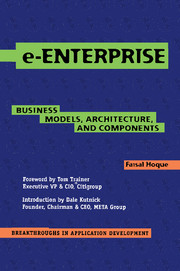Book contents
Afterword: Who Will Be the Great e-Enterprises?
Published online by Cambridge University Press: 20 May 2010
Summary
Let's say you've absorbed all there is to be learned about developing the next successful e-Enterprise. Perhaps you've already moved your learning into the marketplace, and the results have been the best you could have hoped for.
What you have won is the right to compete again.
If there's a bottom-line lesson to everything we know about e-Enterprise, it is this: if you haven't created business and technology architectures that enable you to win and win again—if they aren't robust and repeatable in terms of producing success—then you haven't arrived at e-Enterprise yet.
The right tools in this environment are the ones that allow business leaders to replicate—even automate—business and technology analysis and decision making, iteration after iteration. How else can you stay abreast of market opportunities and ahead of your competitors in today's relentlessly competitive environment? As Tom Trainer, CIO of Citigroup, said in the Foreword, you have to think about business and technology architecture as “a repository of reusable strategic assets that allow your e-Enterprise to evolve as rapidly and continuously as today's fluid markets.” Only that, meshed with an organizational culture and people endlessly motivated to learn more and push ahead, offers an unbeatable combination.
It should be abundantly clear that this book has not been about telling you how to be the next Amazon.com. In fact, we believe that the glory days of the Net-only business model may be coming to an end.
- Type
- Chapter
- Information
- e-EnterpriseBusiness Models, Architecture, and Components, pp. 261 - 264Publisher: Cambridge University PressPrint publication year: 2000



